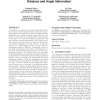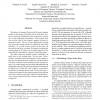147 search results - page 26 / 30 » Dependable k-coverage algorithms for sensor networks |
ALGOSENSORS
2009
Springer
14 years 1 months ago
2009
Springer
Sensor networks, with their ad hoc deployments, node mobility, and wireless communication, pose serious challenges for developing provably correct and efficient applications. A po...
SENSYS
2006
ACM
14 years 1 months ago
2006
ACM
Varying interference levels make broadcasting an unreliable operation in low-power wireless networks. Many routing and resource discovery protocols depend on flooding (repeated pe...
MOBIHOC
2006
ACM
14 years 7 months ago
2006
ACM
Localization is an important and extensively studied problem in ad-hoc wireless sensor networks. Given the connectivity graph of the sensor nodes, along with additional local info...
CDC
2009
IEEE
14 years 2 days ago
2009
IEEE
— We consider the problem of determining the existence of known constant signals over a set of sites, given noisy measurements obtained by a team of active sensors that can switc...
SP
2008
IEEE
14 years 1 months ago
2008
IEEE
The efficacy of Anomaly Detection (AD) sensors depends heavily on the quality of the data used to train them. Artificial or contrived training data may not provide a realistic v...


